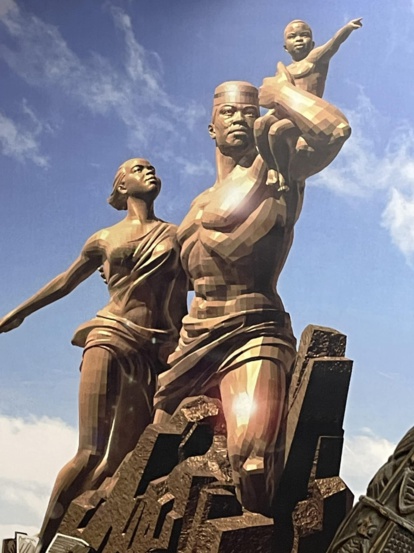The African Renaissance Monument is a colossal statue located on a hill overlooking Dakar, Senegal. Inaugurated on April 4, 2010, it stands as a powerful symbol of Africa's progress and aspirations, blending modern design with deep cultural significance. Designed by the Senegalese architect Pierre Goudiaby Atépa, the monument is among the tallest statues in the world and the tallest in Africa.
Structure and Design:
The statue stands at 49 meters (160 feet) tall and is built on a 100-meter-high (330 feet) hill, giving it a total height of 149 meters (490 feet) above sea level.
The monument features a man, woman, and child pointing towards the horizon, symbolizing African unity, strength, and hope for a prosperous future.
Constructed primarily from bronze, the design combines contemporary aesthetics with traditional African motifs.
Symbolism:
Man: Represents strength and vigor, holding the child aloft as a beacon of hope and leadership.
Woman: Symbolizes nurturing and support, with her gaze turned upward, signifying aspiration and progress.
Child: Points towards the future, embodying the promise of a brighter tomorrow for Africa.
Cultural Significance
Historical Context:
The African Renaissance Monument commemorates Senegal’s 50 years of independence and is meant to celebrate Africa's renaissance and resurgence.
It serves as a reminder of the continent’s rich history and its potential for future growth and development.
Tourist Attraction:
As one of Dakar's key landmarks, the monument attracts numerous visitors, both locals and tourists, who come to appreciate its grandeur and panoramic views of the city and the Atlantic Ocean.
The site includes a museum within the base of the monument that highlights the history of African civilizations and the continent's contributions to world culture.
Educational and Inspirational Role:
The monument serves as an educational tool, promoting African heritage and encouraging reflection on the continent’s past and future.
It stands as a symbol of pride and a source of inspiration for Africans, encouraging unity and a forward-looking vision.
Architect's Vision
Pierre Goudiaby Atépa envisioned the African Renaissance Monument as a testament to Africa’s potential and a statement of confidence in its future. The statue reflects the journey from colonial oppression to freedom and independence, celebrating Africa’s identity and resilience.
Controversies and Criticisms
Despite its positive symbolism, the African Renaissance Monument has faced criticism:
Cost: The project, costing around $27 million, has been criticized for its expense, given Senegal's economic challenges.
Design and Construction: The monument was constructed by North Korean company Mansudae Overseas Projects, which sparked debate over the use of foreign labor and the North Korean artistic style.
Cultural Concerns: Some critics argue that the statue’s appearance and aesthetics do not align with traditional African art forms.
Legacy and Impact
The African Renaissance Monument remains a significant cultural and political symbol. It stands as a powerful representation of Africa’s dreams and aspirations, promoting the idea that the continent can rise to new heights and forge a prosperous path for future generations.
Structure and Design:
The statue stands at 49 meters (160 feet) tall and is built on a 100-meter-high (330 feet) hill, giving it a total height of 149 meters (490 feet) above sea level.
The monument features a man, woman, and child pointing towards the horizon, symbolizing African unity, strength, and hope for a prosperous future.
Constructed primarily from bronze, the design combines contemporary aesthetics with traditional African motifs.
Symbolism:
Man: Represents strength and vigor, holding the child aloft as a beacon of hope and leadership.
Woman: Symbolizes nurturing and support, with her gaze turned upward, signifying aspiration and progress.
Child: Points towards the future, embodying the promise of a brighter tomorrow for Africa.
Cultural Significance
Historical Context:
The African Renaissance Monument commemorates Senegal’s 50 years of independence and is meant to celebrate Africa's renaissance and resurgence.
It serves as a reminder of the continent’s rich history and its potential for future growth and development.
Tourist Attraction:
As one of Dakar's key landmarks, the monument attracts numerous visitors, both locals and tourists, who come to appreciate its grandeur and panoramic views of the city and the Atlantic Ocean.
The site includes a museum within the base of the monument that highlights the history of African civilizations and the continent's contributions to world culture.
Educational and Inspirational Role:
The monument serves as an educational tool, promoting African heritage and encouraging reflection on the continent’s past and future.
It stands as a symbol of pride and a source of inspiration for Africans, encouraging unity and a forward-looking vision.
Architect's Vision
Pierre Goudiaby Atépa envisioned the African Renaissance Monument as a testament to Africa’s potential and a statement of confidence in its future. The statue reflects the journey from colonial oppression to freedom and independence, celebrating Africa’s identity and resilience.
Controversies and Criticisms
Despite its positive symbolism, the African Renaissance Monument has faced criticism:
Cost: The project, costing around $27 million, has been criticized for its expense, given Senegal's economic challenges.
Design and Construction: The monument was constructed by North Korean company Mansudae Overseas Projects, which sparked debate over the use of foreign labor and the North Korean artistic style.
Cultural Concerns: Some critics argue that the statue’s appearance and aesthetics do not align with traditional African art forms.
Legacy and Impact
The African Renaissance Monument remains a significant cultural and political symbol. It stands as a powerful representation of Africa’s dreams and aspirations, promoting the idea that the continent can rise to new heights and forge a prosperous path for future generations.


 Home
Home Welcome
Welcome 

